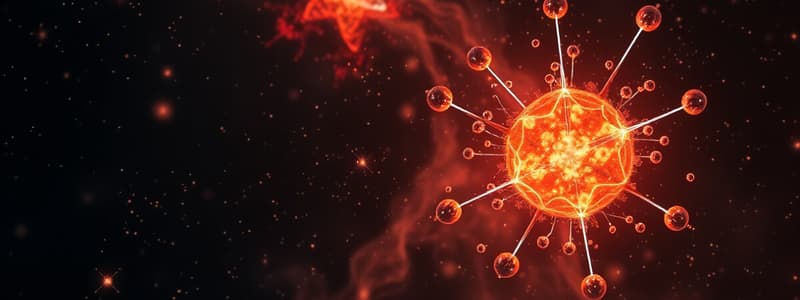Podcast
Questions and Answers
According to the Big Bang theory, the universe originated from an extremely dense and hot state known as ______.
According to the Big Bang theory, the universe originated from an extremely dense and hot state known as ______.
singularity
[Blank] is the process responsible for creating elements heavier than iron and nickel, which are often rarer elements.
[Blank] is the process responsible for creating elements heavier than iron and nickel, which are often rarer elements.
supernova nucleosynthesis
The process of combining two nuclei to form a new element is known as ______.
The process of combining two nuclei to form a new element is known as ______.
nuclear fusion
The term 'atomos', which means indivisible, was used by Leucippus and Democritus to describe the smallest pieces of ______.
The term 'atomos', which means indivisible, was used by Leucippus and Democritus to describe the smallest pieces of ______.
John Dalton's atomic theory states that atoms of a particular ______ have a characteristic average mass that is unique to that entity.
John Dalton's atomic theory states that atoms of a particular ______ have a characteristic average mass that is unique to that entity.
J.J. Thomson's plum pudding model proposed that electrons are like plums embedded in a pudding of ______ charge.
J.J. Thomson's plum pudding model proposed that electrons are like plums embedded in a pudding of ______ charge.
Ernest Rutherford's gold foil experiment led him to propose the ______ model of the atom, where electrons revolve around a positively charged center.
Ernest Rutherford's gold foil experiment led him to propose the ______ model of the atom, where electrons revolve around a positively charged center.
James Chadwick used ______ in his experiment, instead of gold, to discover the neutron.
James Chadwick used ______ in his experiment, instead of gold, to discover the neutron.
Flashcards
Matter
Matter
Anything that occupies space and has mass.
Elements
Elements
Substances that cannot be broken down into simpler substances.
Atom
Atom
Smallest particle of an element.
Big Bang Theory
Big Bang Theory
Signup and view all the flashcards
Big Bang Nucleosynthesis
Big Bang Nucleosynthesis
Signup and view all the flashcards
Nuclear Fusion
Nuclear Fusion
Signup and view all the flashcards
Stellar Nucleosynthesis
Stellar Nucleosynthesis
Signup and view all the flashcards
Modern Atomic Theory
Modern Atomic Theory
Signup and view all the flashcards
Study Notes
- Anything that occupies space is matter
- Matter has mass
- Chemistry deals with the study of matter
- Elements cannot be broken down into simpler substance
- An atom is the smallest particle of an element
Sub atomic particles
- Neutron = Zero charge
- Proton = Positive charge
- Electron = Negative charge
Big Bang Theory
- Universe developed 13.7 billion years ago from a very small, dense, and hot state
- This is called Singularity which started to collapse and expand
Big Bang Nucleosynthesis
- Creates new atomic nucleus from preexisting nucleons
- Light elements formed include Hydrogen, Helium, Lithium, and Beryllium
Nuclear Fusion
- Combines two nucleus's to produce a new element
Stellar Nucleosynthesis
- Lighter elements are fused together within a start to create another element
Supernova Nucleosynthesis
- Responsible for creating rarer elements heavier than iron and nickel
History of the Atom
- Leucippus and Democritus called the small pieces of matter as "Atomos", which means indivisible
- Aristotle affirmed that there are four elements: Fire, Water, Earth and Wind
- John Dalton proposed the modern atomic theory
Modern Atomic Theory
- All matter is composed of atoms
- Atoms cannot be subdivided, created, or destroyed in ordinary chemical reactions
- Atoms of an element have a characteristic average mass which is unique to that element
- Atoms of any one element differs in properties from atoms of another element
J.J. Thompson
- Formulated the plum pudding model of the atom
- The electron particles are like plums in a positively charged pudding
- He used the cathode ray tube experiment to formulate this model
Ernest Rutherford
- Formulated the nuclear model of the atom
- Electrons revolve around a positively charged center of the atom which he called the nucleus
- He used the gold foil experiment where he bombarded it with alpha particle
James Chadwick
- Conducted the same experiment as Ernest Rutherford; Instead of using gold, he used barium
- With his experiment, he was able to discover the subatomic particle neutron
Neils Bohr
- Modified and improved the nuclear model of the atom of Ernest Rutherford
- Placed the electrons in specific energy level to create a planetary atomic model
Atomic Number and Atomic Masses
- Number of Protons = Atomic Number
- Number of Electrons = Number of Protons
- Number of Neutrons = Atomic mass minus number of Protons
- Atomic Mass = No. of Protons plus No. of Neutrons
- Isotopes elements with the same atomic number but different atomic mass
- Formula for isotopes = Ā = (%)(A₁) + (%)(A₂)
Periodic Table of Elements:
- Johann Wolfgang Dobereiner's law of Triads: First to arrange the elements into three
- John a Newlands' Law of Octaves: Arranged the elements according to increasing atomic weight where the chemical properties repeat in an interval of eight
- Dmitri Mendeleev's Periodic Table: arranged the elements according to increasing atomic weight and was first to tabulate the elements
- Henry Moseley's Periodic Table: Arranged the elements according to increasing atomic number
Studying That Suits You
Use AI to generate personalized quizzes and flashcards to suit your learning preferences.




